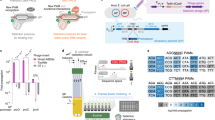Abstract
Nucleases containing programmable DNA-binding domains can alter the genomes of model organisms and have the potential to become human therapeutics. Here we present DNA-binding phage-assisted continuous evolution (DB-PACE) as a general approach for the laboratory evolution of DNA-binding activity and specificity. We used this system to generate transcription activator–like effectors nucleases (TALENs) with broadly improved DNA cleavage specificity, establishing DB-PACE as a versatile approach for improving the accuracy of genome-editing agents.


Similar content being viewed by others
References
Tebas, P. et al. N. Engl. J. Med. 370, 901–910 (2014).
Gaj, T., Gersbach, C.A. & Barbas, C.F. III. Trends Biotechnol. 31, 397–405 (2013).
Epinat, J.C. et al. Nucleic Acids Res. 31, 2952–2962 (2003).
Klug, A. Q. Rev. Biophys. 43, 1–21 (2010).
Maeder, M.L. et al. Mol. Cell 31, 294–301 (2008).
Beerli, R.R., Segal, D.J., Dreier, B. & Barbas, C.F. III. Proc. Natl. Acad. Sci. USA 95, 14628–14633 (1998).
Moscou, M.J. & Bogdanove, A.J. Science 326, 1501 (2009).
Boch, J. et al. Science 326, 1509–1512 (2009).
Deng, D. et al. Science 335, 720–723 (2012).
Mak, A.N., Bradley, P., Cernadas, R.A., Bogdanove, A.J. & Stoddard, B.L. Science 335, 716–719 (2012).
Cong, L., Zhou, R., Kuo, Y.C., Cunniff, M. & Zhang, F. Nat. Commun. 3, 968 (2012).
Lamb, B.M., Mercer, A.C. & Barbas, C.F. III. Nucleic Acids Res. 41, 9779–9785 (2013).
Tsuji, S., Futaki, S. & Imanishi, M. Biochem. Biophys. Res. Commun. 441, 262–265 (2013).
Guilinger, J.P. et al. Nat. Methods 11, 429–435 (2014).
Esvelt, K.M., Carlson, J.C. & Liu, D.R. Nature 472, 499–503 (2011).
Carlson, J.C., Badran, A.H., Guggiana-Nilo, D.A. & Liu, D.R. Nat. Chem. Biol. 10, 216–222 (2014).
Dickinson, B.C., Packer, M.S., Badran, A.H. & Liu, D.R. Nat. Commun. 5, 5352 (2014).
Hu, J.C., Kornacker, M.G. & Hochschild, A. Methods 20, 80–94 (2000).
Choo, Y. & Klug, A. Proc. Natl. Acad. Sci. USA 91, 11163–11167 (1994).
Dickinson, B.C., Leconte, A.M., Allen, B., Esvelt, K.M. & Liu, D.R. Proc. Natl. Acad. Sci. USA 110, 9007–9012 (2013).
Zuris, J.A. et al. Nat. Biotechnol. 33, 73–80 (2015).
Acknowledgements
This work was supported by Defense Advanced Research Projects Agency (DARPA) HR0011-11-2-0003, DARPA N66001-12-C-4207, a grant from the US National Institutes of Health (NIH)/NIGMS (R01 GM095501 and R01 GM065400) and the Howard Hughes Medical Institute. S.Q.T., J.D.S. and J.K.J. were supported by an NIH Director's Pioneer Award (DP1 GM105378). S.Q.T. was supported by NIH F32 GM105189. A.H.B. was supported by the Harvard Chemical Biology Program and a US National Science Foundation Graduate Research Fellowship.
Author information
Authors and Affiliations
Contributions
B.P.H. designed the research, performed experiments, analyzed data and wrote the manuscript. A.H.B. assisted in the design of the one-hybrid system, and A.H.B. and K.M.D. contributed materials and performed experiments. J.A.Z., J.P.G. and L.C. performed experiments and data analysis. S.Q.T. prepared materials for TALEN cleavage analysis in cells. J.D.S. contributed experimentally validated TALE arrays. D.R.L. designed and supervised the research and wrote the manuscript. All of the authors contributed to editing the manuscript.
Corresponding author
Ethics declarations
Competing interests
D.R.L. is a consultant for Editas Medicine. J.K.J. is a consultant for Horizon Discovery. J.K.J. has financial interests in Editas Medicine, Hera Testing Laboratories, Poseida Therapeutics and Transposagen Biopharmaceuticals. J.K.J.'s interests were reviewed and are managed by Massachusetts General Hospital and Partners HealthCare in accordance with their conflict of interest policies.
Supplementary information
Supplementary Text and Figures
Supplementary Figures 1–25, Supplementary Tables 1–4, Supplementary Results, Supplementary Discussion and Supplementary Notes 1–4 (PDF 14767 kb)
Rights and permissions
About this article
Cite this article
Hubbard, B., Badran, A., Zuris, J. et al. Continuous directed evolution of DNA-binding proteins to improve TALEN specificity. Nat Methods 12, 939–942 (2015). https://doi.org/10.1038/nmeth.3515
Received:
Accepted:
Published:
Issue Date:
DOI: https://doi.org/10.1038/nmeth.3515
- Springer Nature America, Inc.
This article is cited by
-
Disulfide-compatible phage-assisted continuous evolution in the periplasmic space
Nature Communications (2021)
-
Directed evolution of rRNA improves translation kinetics and recombinant protein yield
Nature Communications (2021)
-
Orthogonal translation enables heterologous ribosome engineering in E. coli
Nature Communications (2021)
-
Improved pyrrolysine biosynthesis through phage assisted non-continuous directed evolution of the complete pathway
Nature Communications (2021)
-
Multiplex suppression of four quadruplet codons via tRNA directed evolution
Nature Communications (2021)





